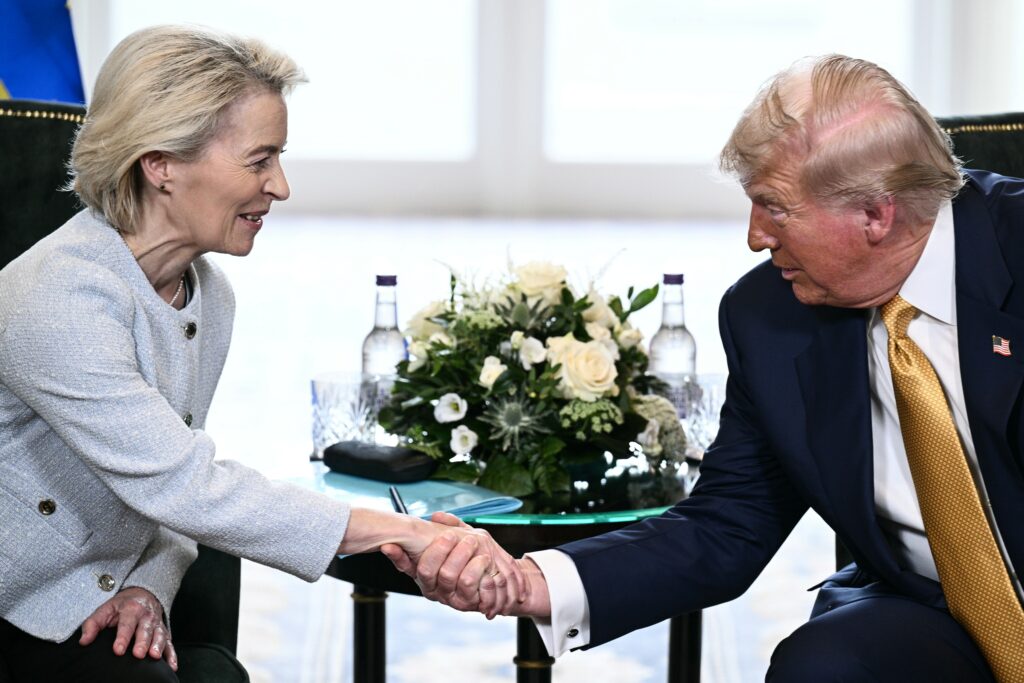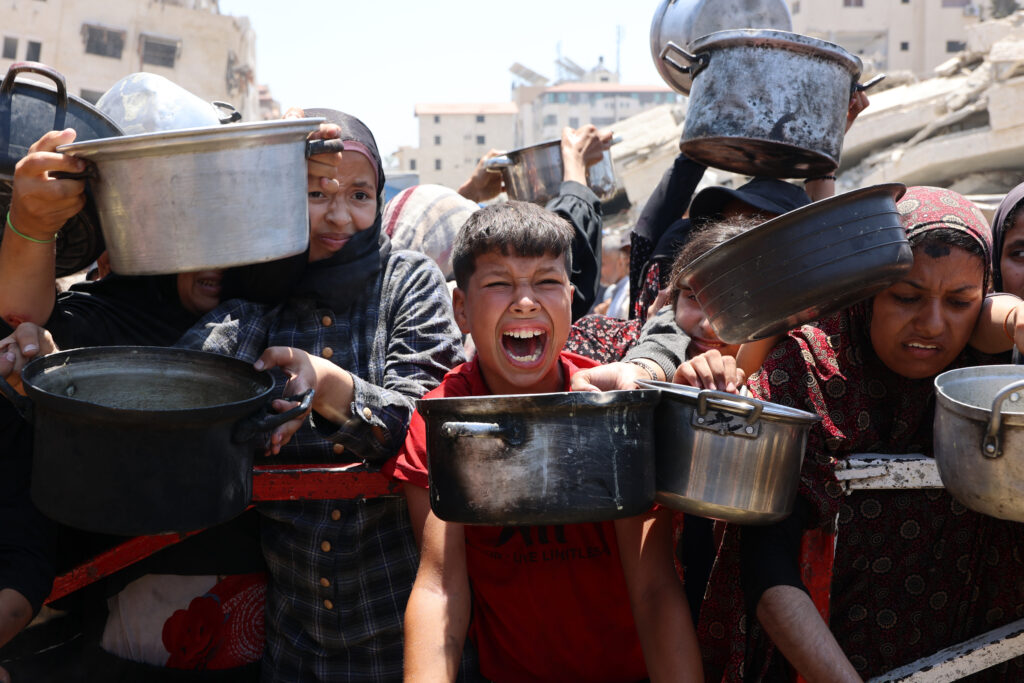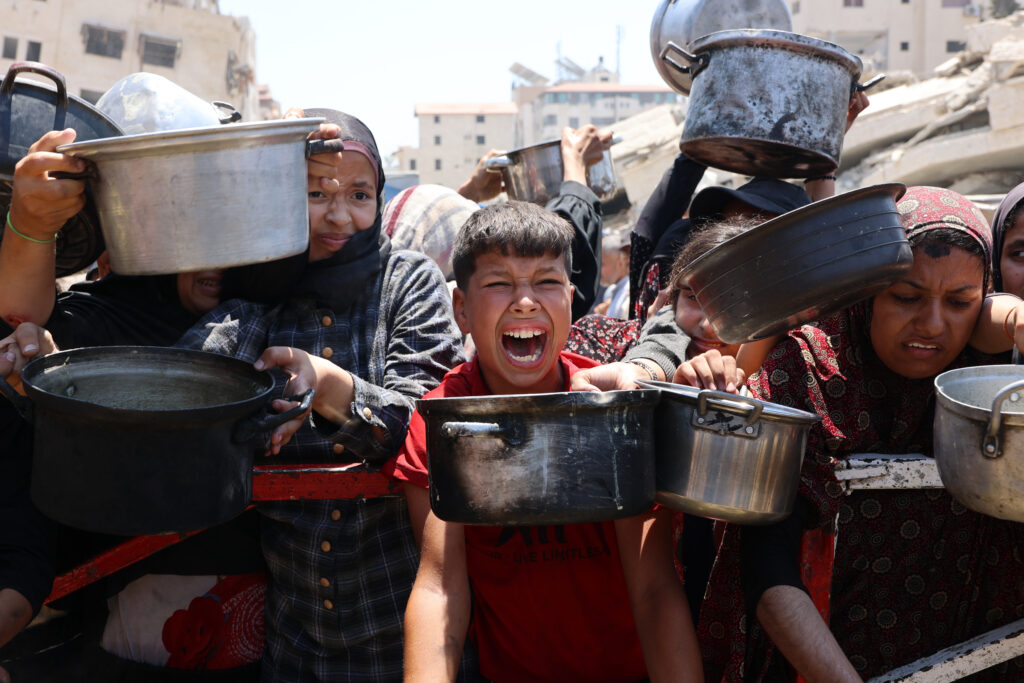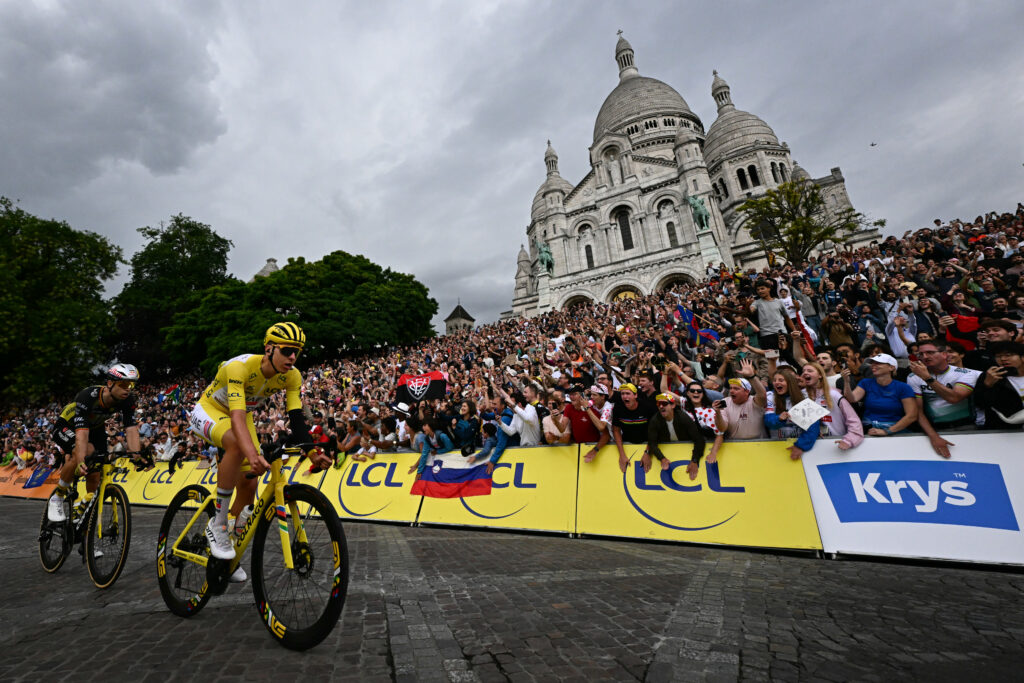Tour de France: Tadej Pogacar, le bouquet final
Grandissime favori au départ, Tadej Pogacar a remporté son quatrième Tour de France dimanche à Paris où, après quelques jours de lassitude, il a animé une dernière étape exceptionnelle remportée par Wout Van Aert sous le déluge sur les Champs-Élysées.Un grand sourire barrait le visage du Slovène lorsqu’il a franchi, le doigt levé, tout en jaune et trempé jusqu’à l’os, la ligne d’arrivée après une incursion inédite sur la butte Montmartre, théâtre d’un final exceptionnel.Après avoir assommé la concurrence dès les Pyrénées et ensuite promené son ennui dans les Alpes, le champion du monde avait décidé de faire la course dimanche. Et le spectacle a été total dans les avenues détrempées de Paris, en particulier dans la rue Lepic, noyée dans une ferveur indescriptible comme il y a un an aux JO, pour cette dernière étape transformée en classique pavée flandrienne.Lorsque le peloton a attaqué la première des trois ascensions de Montmartre, Pogacar n’avait pourtant plus qu’à rallier l’arrivée pour assurer sa victoire finale, puisque les temps au général – 4:24 d’avance sur Jonas Vingegaard – avaient été gelés à cause de la pluie.Une issue qui n’était totalement pas une garantie vu ce qui tombait et l’état de la chaussée, terriblement glissante.Mais le champion du monde, qui avoue préférer les classiques aux grands Tours, a décidé, contrairement à Vingegaard, d’engager un bras de fer époustouflant dès la première montée de la rue Lepic, en suivant un mouvement de Julian Alaphilippe.Passant en tête lors des deux premières ascensions, il a encore attaqué, au sein d’un groupe de six coureurs, lors de la dernière ascension. Mais Van Aert, autre formidable coureur de classiques, a réussi à s’accrocher à sa roue. Avant de lâcher le maillot jaune dans une ambiance indescriptible et d’aller gagner pour la deuxième fois de sa carrière sur les Champs-Élysées.- Il égale Chris Froome -Quatrième de l’étape, Pogacar a ainsi conclu en beauté un Tour de France qu’il aura maîtrisé de bout en bout au point de tuer rapidement tout suspense, après avoir gagné quatre étapes dès les Pyrénées, malgré un rhume.La traversée des Alpes a été très longue pour lui et il a fini par avouer qu’il comptait les jours jusqu’à Paris.A l’approche des Champs-Élysées, Pogacar a modifié son discours. Assurant qu’il avait quand même “apprécié” la course, il a mis sa lassitude sur le compte de la fatigue du Tour “le plus difficile” qu’il ait jamais couru.En six participations, il en est désormais à quatre victoires et deux deuxièmes places, égalant Chris Froome pour se rapprocher à une unité du record détenu par Eddy Merckx, Bernard Hinault, Jacques Anquetil et Miguel Indurain.A seulement 26 ans, le leader d’UAE a largement le temps de les dépasser.Vu qu’il paraît peu probable qu’il dispute la Vuelta, son prochain grand objectif sera la défense de son titre de champion du monde en septembre au Rwanda pour renforcer un peu plus sa candidature au titre de meilleur coureur de tous les temps.Tout n’a pourtant pas été rose et Pogacar a dû composer avec l’abandon de son lieutenant Joao Almeida, des coureurs malades dans son équipe, son propre rhume, les inévitables questionnements sur sa suprématie et l’équipe Visma.- Les jeunes poussent -Mais la stratégie de harcèlement de la formation néerlandaise a fait pschitt et, au final, Vingegaard boucle son plus mauvais Tour depuis 2021, sans victoire d’étape.Après une préparation pourtant idéale et axée sur le Tour, la question se pose: le Danois, qui disputera la Vuelta, ne devrait-il pas élargir son spectre ?D’autant que derrière, les jeunes poussent à l’image de Florian Lipowitz, premier Allemand sur le podium depuis Andreas Klöden en 2006, qui s’est monté bien plus fort que Primoz Roglic, son coéquipier chez Red Bull Bora (8e).”Lipo” a aussi profité de l’abandon de Remco Evenepoel qui pourrait le rejoindre dès 2026 dans l’équipe allemande.Quatrième, le Britannique Oscar Onley, 22 ans, représente également l’avenir.Deux Français qu’on n’attendait pas à ce niveau se glissent dans le Top 10 avec la septième place de Kévin Vauquelin et la dixième de Jordan Jégat.Le premier a réussi un Tour enthousiasmant au sein d’une équipe Arkéa-B&B Hotels qui aurait difficilement pu faire mieux pour convaincre des partenaires à la sauver de la disparition.Jegat, longtemps resté chez les amateurs, a montré avec panache qu’il n’y a pas forcément besoin d’être super fort à 18 ans pour avoir un avenir dans le cyclisme.
Trump, EU chief strike trade deal in transatlantic standoff
US President Donald Trump and EU chief Ursula von der Leyen Sunday announced they had reached a deal to end a transatlantic tariffs standoff and avert a full-blown trade war.The agreement came as the clock ticked down on an August 1 deadline for the European Union to strike a deal with Washington — or face an across-the-board US levy of 30 percent.”We have reached a deal. It’s a good deal for everybody,” Trump told reporters following a high-stakes meeting with von der Leyen at his golf resort in Turnberry, Scotland.Trump told reporters the deal involved a baseline levy of 15 percent on EU exports to the United States — the same level secured by Japan — including for the bloc’s crucial auto sector, which is currently being taxed at 25 percent.”We are agreeing that the tariff straight across, for automobiles and everything else, will be a straight across tariff of 15 percent,” Trump said.He also said the bloc had agreed to purchase “$750 billion worth of energy” from the United States, as well as $600 billion more in additional investments in the country.Negotiating on behalf of the EU’s 27 countries, von der Leyen’s European Commission had been pushing hard to salvage a trading relationship worth an annual $1.9 trillion in goods and services.”It’s a good deal,” the EU chief told reporters, sitting alongside Trump following their hour-long talks.”It will bring stability. It will bring predictability. That’s very important for our businesses on both sides of the Atlantic,” she said.- No carve-outs -The EU has been hit by multiple waves of tariffs since Trump reclaimed the White House. It is currently subject to a 25-percent levy on cars, 50 percent on steel and aluminium, and an across-the-board tariff of 10 percent, which Washington threatens to hike to 30 percent in a no-deal scenario.Brussels has been focused on getting a deal to avoid sweeping tariffs that would further harm its sluggish economy — with retaliation held out as a last resort.But the deal as outlined by Trump appeared to fall short of EU expectations.The bloc had been pushing hard for tariff carve-outs for critical industries from aircraft to spirits, and its auto industry, crucial for France and Germany, is already reeling from the levies imposed so far.Any deal will also need to be approved by EU member states — whose ambassadors, on a visit to Greenland, were updated by the commission Sunday morning. They were set to meet again after the deal struck in Scotland.Trump said pharmaceuticals — a key export for Ireland, which the bloc has lobbied to shield — “won’t be part of” any deal.”We have to have them built, made in the United States,” the president said. This month, Trump suggested the possibility of a 200-percent tariff on drugs imported into the United States, which would deal a crushing blow to the sector in Europe.The EU had also hoped for a compromise on steel that could allow a certain quota into the United States before tariffs would apply, but Trump ruled that out, saying steel was “staying the way it is”.- Auto sector -While 15 percent would be much higher than pre-existing US tariffs on European goods, which average around 4.8 percent, it would mirror the status quo, with companies currently facing an additional flat rate of 10 percent.Had the talks failed, EU states had greenlit counter tariffs on $109 billion (93 billion euros) of US goods including aircraft and cars to take effect in stages from August 7. Brussels was also drawing up a list of US services to potentially target.Beyond that, countries including France say Brussels should not be afraid to deploy a so-called trade “bazooka” — EU legislation designed to counter coercion that can involve restricting access to its market and public contracts.Trump has embarked on a campaign to reshape US trade with the world, and has vowed to hit dozens of countries with punitive tariffs if they do not reach a pact with Washington by August 1.US Commerce Secretary Howard Lutnick had said Sunday the August 1 deadline was firm and there will be “no extensions, no more grace periods”.
Largages d’aide sur Gaza, Israël annonce une pause des combats
Les largages d’aide ont repris dimanche sur la bande de Gaza assiégée, où la malnutrition a atteint des “niveaux alarmants” selon l’ONU, après l’annonce israélienne d’une pause des combats à des fins humanitaires dans certains secteurs.Les premiers camions chargés d’aide ont également traversé dimanche la frontière depuis l’Egypte vers le point de passage israélien de Kerem Shalom, distant de quelques kilomètres, pour y être inspectés avant d’entrer dans la bande de Gaza.Des images de l’AFP montrent une file de camions chargés de sacs blancs traversant, du côté égyptien, l’entrée du terminal de Rafah où le poste-frontière du côté palestinien est fermé depuis plus d’un an.Depuis les airs, trois avions jordaniens et émirati ont largué 25 tonnes d’aide sur le territoire palestinien affamé. L’armée israélienne a elle aussi annoncé avoir parachuté de l’aide, après des semaines de pression internationale pour permettre l’arrivée de vivres pour la population du territoire ravagé par la guerre, déclenchée par l’attaque sans précédent du mouvement islamiste palestinien Hamas le 7 octobre 2023.- “La faim est impitoyable” -“Des avions israéliens ont largué sept caisses de vivres (…) dans le nord-ouest de la ville de Gaza. Des dizaines de personnes se sont précipitées pour les récupérer, on dirait une guerre. Tout le monde essayait d’attraper tout ce qu’il pouvait”, témoigne Samih Humaid, 23 ans, qui dit être rentré avec “seulement trois boîtes de fèves”. “La faim est impitoyable”, ajoute-t-il.De précédents parachutages, menés en 2024 par plusieurs pays, avaient été jugés dangereux et de portée limitée par nombre d’ONG.”Nous avons entendu aux informations que des camions transportant de la farine et de la nourriture allaient entrer à Gaza. Nous espérons que s’ils entrent, ils parviendront jusqu’à nous”, raconte à l’AFP Souad Ishtaywi, une femme de 30 ans qui vit sous une tente dans le nord de Gaza.Israël, qui assiège la bande de Gaza depuis le début de la guerre, avait imposé début mars un blocus hermétique au territoire, très partiellement assoupli fin mai, qui a entraîné de très graves pénuries.L’ONU et des ONG s’alarment d’une flambée de la malnutrition infantile et d’un risque de famine généralisée parmi ses plus de deux millions d’habitants.Les taux de malnutrition dans la bande de Gaza atteignent “des niveaux alarmants”, a prévenu dimanche l’Organisation mondiale de la santé (OMS), estimant que le “blocage délibéré” de l’aide humanitaire avait coûté la vie à de nombreux habitants.A Beit Lahia, dans le nord de Gaza, des images de l’AFP montrent des foules de Palestiniens marchant dimanche dans le sable au milieu des ruines, portant sur le dos des sacs de farine qu’ils venaient de récupérer au poste-frontière de Zikim.- “Plus d’excuses” -La Jordanie avait annoncé l’envoi de 60 camions transportant 962 tonnes de denrées alimentaires vers ce point de passage.Israël a annoncé qu’une “pause tactique” serait observée quotidiennement de 10H00 à 20H00, pour permettre la distribution de l’aide dans les zones de Deir-el-Balah (centre), Al-Mawassi (sud) et la ville de Gaza (nord), selon l’armée.Israël nie depuis des mois tout blocage de l’aide et affirme ne pas être responsable des pénuries, accusant le Hamas de piller les cargaisons et les organisations humanitaires de ne pas les distribuer. Mais ces organisations affirment qu’Israël impose des restrictions excessives à l’entrée de l’aide.”Il existe des couloirs sécurisés. Ils ont toujours existé, mais aujourd’hui, c’est officiel. Il n’y aura plus d’excuses”, a déclaré plus tôt le Premier ministre Benjamin Netanyahu.La Défense civile de Gaza a annoncé dimanche que 27 personnes avaient été tuées dans le territoire, pour la plupart avant l’annonce de la pause des combats. Le chef des opérations humanitaires de l’ONU, Tom Fletcher, a salué cette annonce “bienvenue”.”En contact avec nos équipes sur le terrain qui feront tout leur possible pour atteindre autant de personnes affamées que possible”, a-t-il écrit sur X.- Besoins “immenses” -“C’est une étape bienvenue, mais nous devons voir des progrès réels sur le terrain”, a déclaré à l’AFP Bushra Khalidi, une responsable de l’ONG Oxfam.”L’assistance dont ont besoin les familles gazaouies est immense, elle va bien au-delà de simples colis de nourriture”, a dit à l’AFP Rosalia Bollen, une porte-parole de l’Unicef.Un bateau exploité par le mouvement propalestinien “Flottille pour la liberté”, le Handala, est arrivé dimanche dans le port israélien de Ashdod après avoir été intercepté en Méditerranée par l’armée alors qu’il se dirigeait vers Gaza, chargé d’aide.La guerre a été déclenchée par une attaque sans précédent menée par le mouvement islamiste Hamas en Israël le 7 octobre 2023, qui a entraîné du côté israélien la mort de 1.219 personnes, en majorité des civils, selon un décompte de l’AFP réalisé à partir de données officielles.En riposte à l’attaque, Israël a lancé une offensive qui a fait au moins 59.821 morts à Gaza, en majorité des civils, selon des données du ministère de la Santé du Hamas, jugées fiables par l’ONU.
Largages d’aide sur Gaza, Israël annonce une pause des combats
Les largages d’aide ont repris dimanche sur la bande de Gaza assiégée, où la malnutrition a atteint des “niveaux alarmants” selon l’ONU, après l’annonce israélienne d’une pause des combats à des fins humanitaires dans certains secteurs.Les premiers camions chargés d’aide ont également traversé dimanche la frontière depuis l’Egypte vers le point de passage israélien de Kerem Shalom, distant de quelques kilomètres, pour y être inspectés avant d’entrer dans la bande de Gaza.Des images de l’AFP montrent une file de camions chargés de sacs blancs traversant, du côté égyptien, l’entrée du terminal de Rafah où le poste-frontière du côté palestinien est fermé depuis plus d’un an.Depuis les airs, trois avions jordaniens et émirati ont largué 25 tonnes d’aide sur le territoire palestinien affamé. L’armée israélienne a elle aussi annoncé avoir parachuté de l’aide, après des semaines de pression internationale pour permettre l’arrivée de vivres pour la population du territoire ravagé par la guerre, déclenchée par l’attaque sans précédent du mouvement islamiste palestinien Hamas le 7 octobre 2023.- “La faim est impitoyable” -“Des avions israéliens ont largué sept caisses de vivres (…) dans le nord-ouest de la ville de Gaza. Des dizaines de personnes se sont précipitées pour les récupérer, on dirait une guerre. Tout le monde essayait d’attraper tout ce qu’il pouvait”, témoigne Samih Humaid, 23 ans, qui dit être rentré avec “seulement trois boîtes de fèves”. “La faim est impitoyable”, ajoute-t-il.De précédents parachutages, menés en 2024 par plusieurs pays, avaient été jugés dangereux et de portée limitée par nombre d’ONG.”Nous avons entendu aux informations que des camions transportant de la farine et de la nourriture allaient entrer à Gaza. Nous espérons que s’ils entrent, ils parviendront jusqu’à nous”, raconte à l’AFP Souad Ishtaywi, une femme de 30 ans qui vit sous une tente dans le nord de Gaza.Israël, qui assiège la bande de Gaza depuis le début de la guerre, avait imposé début mars un blocus hermétique au territoire, très partiellement assoupli fin mai, qui a entraîné de très graves pénuries.L’ONU et des ONG s’alarment d’une flambée de la malnutrition infantile et d’un risque de famine généralisée parmi ses plus de deux millions d’habitants.Les taux de malnutrition dans la bande de Gaza atteignent “des niveaux alarmants”, a prévenu dimanche l’Organisation mondiale de la santé (OMS), estimant que le “blocage délibéré” de l’aide humanitaire avait coûté la vie à de nombreux habitants.A Beit Lahia, dans le nord de Gaza, des images de l’AFP montrent des foules de Palestiniens marchant dimanche dans le sable au milieu des ruines, portant sur le dos des sacs de farine qu’ils venaient de récupérer au poste-frontière de Zikim.- “Plus d’excuses” -La Jordanie avait annoncé l’envoi de 60 camions transportant 962 tonnes de denrées alimentaires vers ce point de passage.Israël a annoncé qu’une “pause tactique” serait observée quotidiennement de 10H00 à 20H00, pour permettre la distribution de l’aide dans les zones de Deir-el-Balah (centre), Al-Mawassi (sud) et la ville de Gaza (nord), selon l’armée.Israël nie depuis des mois tout blocage de l’aide et affirme ne pas être responsable des pénuries, accusant le Hamas de piller les cargaisons et les organisations humanitaires de ne pas les distribuer. Mais ces organisations affirment qu’Israël impose des restrictions excessives à l’entrée de l’aide.”Il existe des couloirs sécurisés. Ils ont toujours existé, mais aujourd’hui, c’est officiel. Il n’y aura plus d’excuses”, a déclaré plus tôt le Premier ministre Benjamin Netanyahu.La Défense civile de Gaza a annoncé dimanche que 27 personnes avaient été tuées dans le territoire, pour la plupart avant l’annonce de la pause des combats. Le chef des opérations humanitaires de l’ONU, Tom Fletcher, a salué cette annonce “bienvenue”.”En contact avec nos équipes sur le terrain qui feront tout leur possible pour atteindre autant de personnes affamées que possible”, a-t-il écrit sur X.- Besoins “immenses” -“C’est une étape bienvenue, mais nous devons voir des progrès réels sur le terrain”, a déclaré à l’AFP Bushra Khalidi, une responsable de l’ONG Oxfam.”L’assistance dont ont besoin les familles gazaouies est immense, elle va bien au-delà de simples colis de nourriture”, a dit à l’AFP Rosalia Bollen, une porte-parole de l’Unicef.Un bateau exploité par le mouvement propalestinien “Flottille pour la liberté”, le Handala, est arrivé dimanche dans le port israélien de Ashdod après avoir été intercepté en Méditerranée par l’armée alors qu’il se dirigeait vers Gaza, chargé d’aide.La guerre a été déclenchée par une attaque sans précédent menée par le mouvement islamiste Hamas en Israël le 7 octobre 2023, qui a entraîné du côté israélien la mort de 1.219 personnes, en majorité des civils, selon un décompte de l’AFP réalisé à partir de données officielles.En riposte à l’attaque, Israël a lancé une offensive qui a fait au moins 59.821 morts à Gaza, en majorité des civils, selon des données du ministère de la Santé du Hamas, jugées fiables par l’ONU.
Tour de France: à Montmartre, la mythique rue Lepic en ébullition avant la montée du peloton
Chaises pliantes, canettes de bière, maillots jaunes et à pois, drapeaux aux fenêtres et déjà des vivats: dans la pente de l’emblématique rue Lepic de Montmartre, des milliers de supporters du Tour de France s’échauffent dimanche avant le passage du peloton en fin d’après-midi.Le spectacle a commencé dès le matin avec des dizaines de cyclistes amateurs qui préparent les pavés de la voie mythique, acclamés comme des champions, dans une ambiance de fête. “Lui, c’est la star de la matinée, ça fait au moins vingt fois qu’il passe !”, s’enthousiasme Kilian Parent, assis depuis huit heures du matin dans sa chaise pliante sur le trottoir de la rue Lepic, où la foule grossit d’heure en heure.Ce jeune Bordelais de 24 ans explique à l’AFP avoir l’habitude d’aller voir le Tour dans les Pyrénées. Cette année, il n’a pas voulu rater le passage historique à Montmartre pour l’ultime étape de la Grande Boucle.C’est sur cette voie située à deux pas de la basilique du Sacré-Coeur que le monde avait assisté à l’épreuve des Jeux olympiques de cyclisme sur route, qui s’est déroulée devant 500.000 spectateurs en liesse le 3 août 2024.- “l’ambiance des JO” -“On est là pour essayer de revivre l’ambiance des JO. Ça ne sera peut-être pas aussi fort mais tout aussi mémorable, d’autant qu’il y aura plus de cyclistes”, anticipe son frère Kevin, en se resservant une bière tirée de sa glacière.”Quand on a vu l’épreuve à la télévision l’année dernière, on s’est dit qu’on voulait en être”, témoigne Andrew Easey, un touriste anglais venu de Gloucester. “Il y a deux ans, j’étais aux Tuileries pour voir l’arrivée des coureurs, l’ambiance était extraordinaire mais là c’est encore mieux… alors que ça n’a pas encore commencé !”, ajoute ce retraité.”C’est mythique, aujourd’hui aussi”, observe, heureux, Didier Bical, membre de la République de Montmartre, en distribuant à la foule le journal de cette association philanthropique fondée par le peintre Francisque Poulbot. A l’arrivée du Tour, le président de cette association remettra un prix au vainqueur des trois passages sur la butte.Plantés devant le fameux restaurant du Moulin de la Galette, en haut de la rue Lepic, Paul et Adrien n’entendent pas bouger d’un pouce. “On est aux deux tiers de la pente, c’est dans cette partie là qu’ils vont attaquer pour faire la différence”, analyse Adrien, 24 ans.- “Plus de suspense” -“C’est top! Il y a plus de suspense que sur les Champs-Élysées où tout le monde va très vite”, s’enthousiasme Valérie Wiart, 52 ans, venue de Lille, où elle a assisté au départ du Tour.”On voit les coureurs de plus près quand ils grimpent”, abonde Cheryl Miller, une belge de 59 ans qui vit à Washington. Comme elle, de très nombreux touristes se sont déplacés exprès pour la course, une occasion aussi de visiter la capitale.”C’est la première fois qu’on vient à Paris et qu’on voit le Tour de France. On est très excités, l’ambiance est géniale !”, disent de concert Erika et son neveu Timon, venus de Hongrie.Guy et Annie Florentin, un couple de retraités troyens, n’avaient eux pas mis les pieds à Paris depuis 30 ans. Et jamais vu Montmartre, dont ils ont voulu découvrir les coins pittoresques, comme le cimetière de Saint-Vincent où repose Michou -figure de la nuit parisienne disparue en 2020-, avant de plonger dans la foule.Ils se disent “un peu gênés” par les performances de Tadej Pogacar, en passe de décrocher une quatrième victoire finale dans le Tour de France. “Il est bon en tout, en sprint, montagne, en contre la montre… Peut-être qu’il ne se dope pas mais j’ai des doutes”, confie Guy, ancien réparateur de vélo et grand fan du Tour.Kevin Parent pense au contraire que le Slovène “apporte un vent de fraîcheur” à la course. “Je ne crois pas qu’il soit dopé. Et puis si on commence à se remémorer les mauvaises époques du dopage, on arrête de vibrer”.
Grèce: deuxième jour de lutte contre des incendies “titanesques”
Les pompiers grecs poursuivaient dimanche leur lutte contre les incendies, attisés par le vent et une canicule persistante, mais la situation s’améliorait dans certaines régions, selon les autorités.Au total, 55 nouveaux feux se sont déclarés au cours des dernières 24 heures, dont 50 qui ont été immédiatement maîtrisés, ont affirmé les pompiers.Cinq foyers ravageaient dimanche soir la région du Péloponnèse, l’ouest d’Athènes, ainsi que les îles d’Eubée, de Cythère et de Crète.Certains étaient toutefois en recul ou en train d’être maitrisés, notamment en Crète.Les flammes continuaient dans la péninsule du Péloponnèse (sud-ouest) ainsi que sur les îles d’Eubée et de Cythère, où des avions et des hélicoptères ont repris leurs opérations dès l’aube, selon les pompiers.En début de matinée, le porte-parole des pompiers, Vassilis Vathrakogiannis, avait prévenu que le risque d’incendie restait “très élevé sur presque l’ensemble du territoire”. La vague de chaleur intense, qui sévit dans ce pays méditerranéen coutumier des températures élevées en été, devrait en outre marquer le pas à partir de lundi avec des maximales attendues à 39°C localement. Dimanche, au septième jour consécutif de canicule, un maximum de 42,4°C a été relevé à Thèbes (centre) – après 45,2°C enregistrés la veille dans l’ouest.- Bataille titanesque -De nombreux incendies ont été signalés dimanche après-midi sur l’île d’Eubée, près d’Athènes, où les flammes ont réduit en cendres des milliers d’hectares de forêt et tué des milliers de têtes de bétail.Des ouvriers ont travaillé toute la journée pour réparer les dommages causés au réseau électrique d’Eubée, et certains villages ont été confrontés à des coupures d’eau. Le risque d’incendie devrait rester très élevé lundi dans six régions du pays, a averti la protection civile.Samedi, les pompiers avaient dû livrer “une bataille titanesque face à des dizaines d’incendies” à travers le pays, a souligné le Premier ministre Kyriakos Mitsotakis, pointant du doigt “l’aggravation de la crise environnementale”. Cinq pompiers ont été hospitalisés.Sur l’île de Cythère, confrontée à “une énorme catastrophe” selon la chaîne publique ERT, l’incendie faisait toujours rage dimanche après-midi, mais sur des fronts plus petits.”Des maisons, des ruches, des oliviers ont été brûlés”, a expliqué à ERT Giorgos Komninos, le maire adjoint de Cythère. “Un monastère est actuellement en danger”, a-t-il ajouté.Près de 70 pompiers soutenus par des bénévoles, trois hélicoptères et deux avions combattaient l’incendie sur cette île, qui a entraîné samedi l’évacuation d’une plage touristique.Les autorités locales ont demandé l’instauration de l’état d’urgence, afin que les mécanismes d’aide puissent être déclenchés sur l’île de 3.600 habitants prisée des touristes.- Crainte de pillages -En Crète, destination très touristique, les pompiers ont maîtrisé un brasier à La Canée, selon l’agence de presse grecque ANA.La Grèce, qui connaît chaque été des feux destructeurs, a demandé l’aide de l’Union européenne avec six avions de lutte contre les incendies, via le programme européen de partage de ressources (RescEU). Deux avions italiens sont attendus dimanche tandis que des unités spécialisées venues de République tchèque sont déjà en action.À Kryoneri, au nord d’Athènes, la police a renforcé la sécurité pour prévenir le pillage des maisons abandonnées par des habitants fuyant les flammes, lesquelles ont été en grande partie maîtrisées dimanche.”Qu’est-ce qu’on peut faire ? On ne sait pas (…). J’espère que nous serons sauvés. Des gens ont perdu leurs biens”, commentait, ému, Giorgos, un habitant du village.Selon l’agence ANA, un homme de 51 ans a été arrêté dimanche, pour avoir utilisé une meule électrique devant une maison à Vromopousi Keratea, en infraction aux mesures de prévention.Les incendies qui se multiplient à travers le globe sont associés à divers phénomènes anticipés par les scientifiques en raison du réchauffement de la planète.





